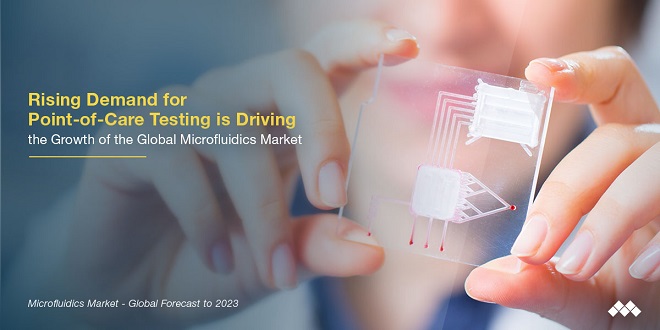Rising demand for point-of-care testing
The rising prevalence of lifestyle-related & infectious diseases and an increasing preference for self-testing are driving the global point-of-care diagnostics market. In addition, growing private investments and the availability of venture funding for the development of new products, coupled with government support for improving the adoption of POC devices, are further supporting the growth of the POC diagnostics market. The rising incidence and prevalence of various diseases, coupled with product miniaturization and the decentralization of healthcare, are the major factors that are expected to offer significant growth opportunities to players operating in the POC diagnostics market.
According to the National Cancer Institute, the cost of cancer treatment in the US was USD 125 billion in 2010; this is expected to reach USD 158 billion by 2020. According to the World Cancer Research Fund International (WCRFI), in 2012, there were an estimated 14.1 million new cancer cases worldwide; this figure increased to 17.5 million in 2015 and is expected to reach 24 million by 2035. The rising incidence of cancer is expected to increase the uptake of cancer-related diagnostic technologies. Similarly, the increasing incidence of other major chronic and infectious diseases, coupled with advancements in coagulation tests, blood gas electrolytes, hematology, urine chemistry, and cardiac markers, are creating new avenues for the growth of the POC diagnostics market. This, in turn, is expected to support the growth of the microfluidics market, as POC testing is the largest segment of the microfluidics market for in vitro diagnostics.
Significant return on investment
Microfluidics is proving an economical solution for screening samples against reagents when testing for toxicity or in research on biomarkers. Microfluidics significantly reduces the cost per test by reducing overall reagent consumption. Nine out of the top fifteen pharmaceutical firms, including Merck, Novartis, GSK, Pfizer, and Sanofi-Aventis, have adopted microfluidic-based micro-reactors to control parameters in chemical reactions and better understand and enhance the quality of production. While the initial investment in microfluidic devices is usually higher than that for their conventional counterparts, reductions in reagent consumption down the line make these devices highly economical in the long run.
Using microfluidics-based devices can accelerate drug discovery as these devices assist in finding new and promising drug targets. This decreases the cost of drug discovery and development. Currently, the majority of pharmaceutical companies and governments across developed and developing countries are focusing on cost-cutting measures. This has further encouraged the usage of microfluidics-based devices.
Entry of new players and the launch of new and advanced products
The ecosystem in the microfluidics market is changing rapidly with the launch of new products, entry of new players, rapidly growing IP base, and acquisitions. Over the last few years, the market has witnessed the emergence of several new small players and spinoffs focusing majorly on technology and product development. Several established players in the diagnostics and life sciences markets are focusing on acquiring these promising small players with a focus on adding and integrating new technologies to their portfolios. This also proves beneficial for smaller companies by expanding their marketing and distribution capabilities. This, in turn, allows them to achieve maximum potential sales for their products.
On the other hand, the complex and time-consuming approval process is hampering the introduction of new products in the market. For example, in the US, the FDA approval process for medical devices has become lengthy over the years. The average approval time for a 510(K) application increased to 151 days during 2011–2015, as opposed to 96 days in 2001–2005. This is expected to have a major impact on the drug delivery, pharmaceutical, and IVD industries. Furthermore, during the approval process, it is not certain whether the product will receive approval, or whether the terms of the approval may have a negative impact on the profitability of the product. Any enforcement action by governments also results in negative publicity, which impacts the market adversely.
Enjoyed this article? Don’t forget to share.

Mayur Jain
Mayur is working in MnM as a research analyst in the healthcare domain for three years. He has worked on syndicated market research reports including lateral flow assay market, and immunohistochemistry market among others. At MnM, Mayur has been enriching his knowledge in market sizing & forecasting, competitive intelligence mapping, data mining, primary/secondary research, market assessment, industry analysis, among others. Mayur completed his Bachelors in Pharmaceutical Sciences from Pune University (India) and Post-Graduation Diploma in Management (IB) from Indira Schools of Business Studies, Pune (India).





